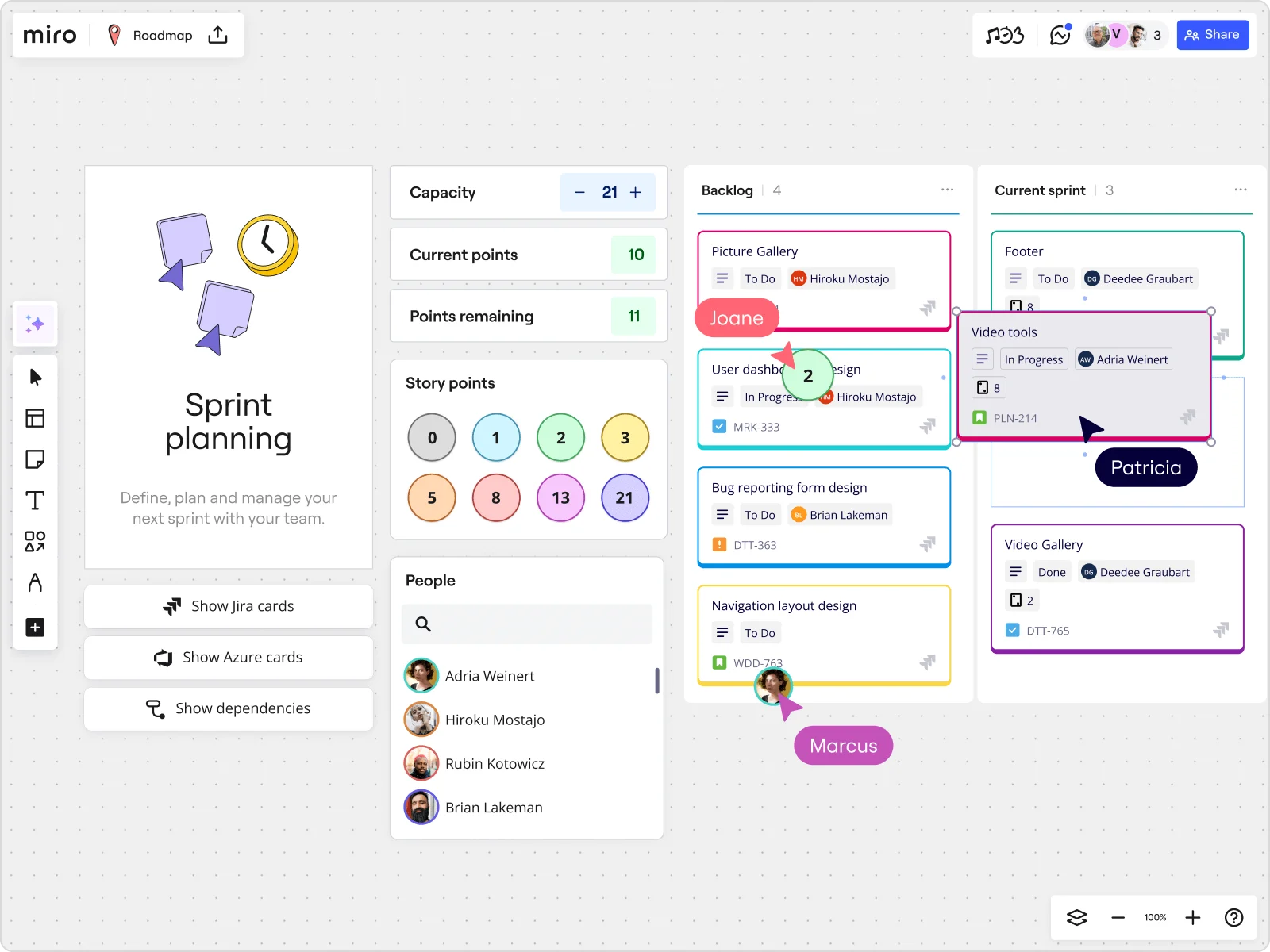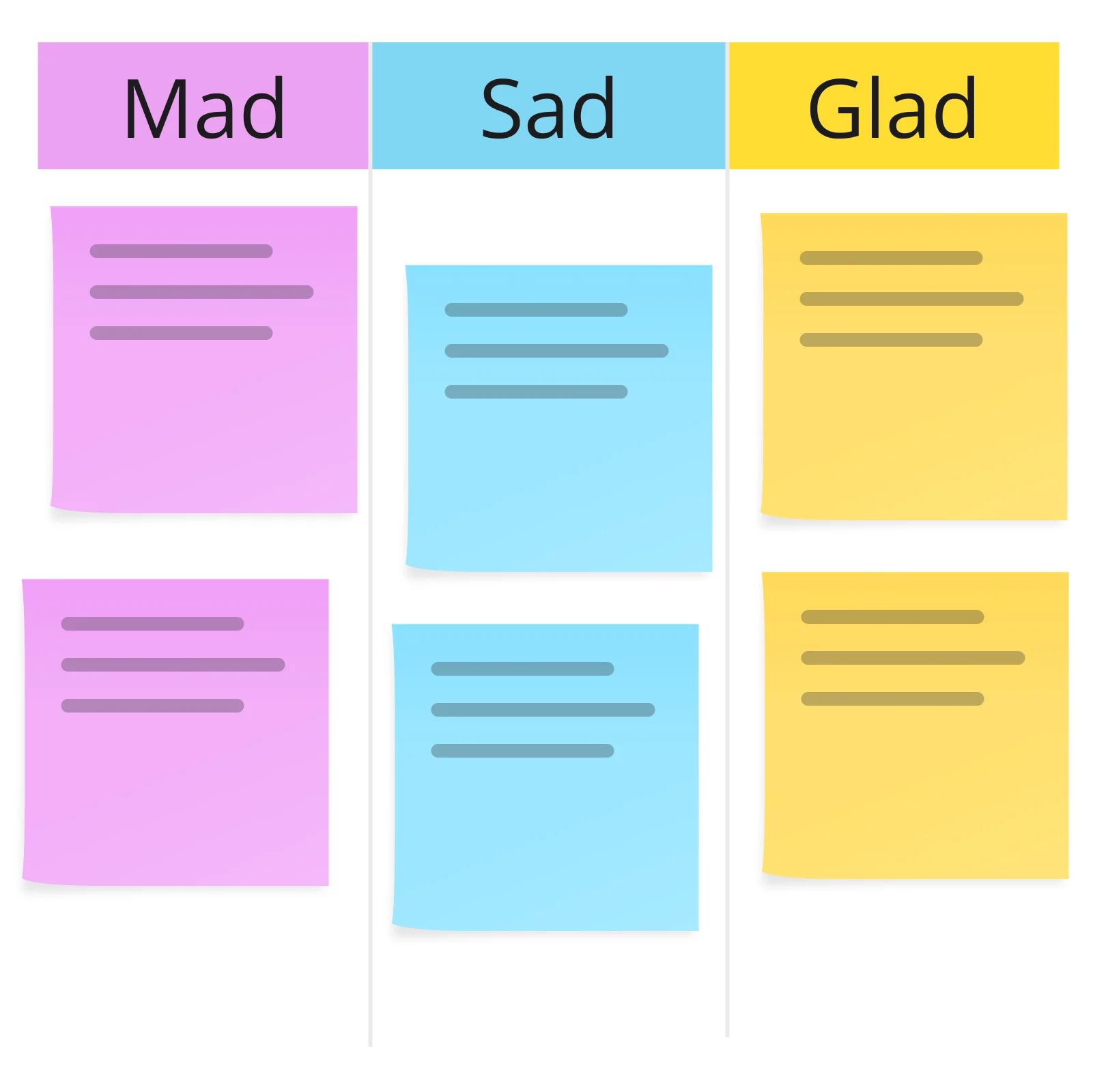
Agile methodology — everything you need to know

Summary
In this guide, you will learn:
What Agile methodology is and its core principles
Key Agile frameworks like Scrum and Kanban
How Agile supports iterative development, feedback, and collaboration
The role of tools like Miro in Agile workflows
How Agile teams plan, execute, and review work
Ways to integrate Agile with other platforms and use AI
Agile methodology is more than just a project management approach. It's a mindset, a culture, a way of working that embraces change and values collaboration.
In this guide, will explain everything you need to know about the Agile methodology for you — including core principles, terms, ceremonies, and practices.
We'll also explore how Agile contrasts with traditional project management methods. Not to mention, how it can drive innovation and efficiency in your team.
Let's dive in.
Try Miro now
Optimize your work with our Agile workflow tool
What is the Agile methodology?
Agile methodology reshapes how teams approach projects. It emerged as a response to rigid and slow traditional methodologies.
At its heart, Agile is about flexibility and responsiveness. Teams using Agile adapt to change rather than sticking to preset plans. This adaptability makes Agile perfect for dynamic environments.
Agile focuses on delivering value through iterative development cycles. Each cycle, or "sprint," is an opportunity to refine the product, based on feedback.
Central to Agile is collaboration. Agile teams prioritize communication, constantly exchanging ideas and feedback. This helps maintain alignment toward common goals.
Here are some key benefits of Agile methodology:
Enhanced customer satisfaction through continuous delivery
Improved product quality with regular updates and feedback
Higher team morale thanks to empowering self-organization
These aspects make Agile an attractive choice for teams seeking innovation and efficiency.

Agile Manifesto core values
The Agile Manifesto is the backbone of Agile methodology. Crafted by thought leaders, it outlines essential values guiding Agile practices.
These values shift the focus from processes to people and their interactions. The Manifesto emphasizes collaboration over contract negotiation.
Here are the four core values of the Agile Manifesto:
Individuals and interactions over processes and tools
Working software over comprehensive documentation
Customer collaboration over contract negotiation
Responding to change over following a plan
The emphasis is on delivering value and embracing change. Agile teams create products that meet user needs and adapt to evolving demands. By prioritizing these values, teams can stay aligned with Agile’s intent.
12 principles behind the Agile Manifesto
The Agile Manifesto's core values are supported by 12 guiding principles. These principles help teams translate Agile values into actionable practices.
1. Satisfy the customer
"Our highest priority is to satisfy the customer." Delivering valuable software early and continuously ensures customer satisfaction.
2. Welcome changing requirements
Agile promotes "Welcoming changing requirements," even late in development. Change is seen as a competitive advantage.
3. Deliver working software frequently
Agile advocates for "Delivering working software frequently." Short timescales allow teams to obtain feedback and make improvements swiftly.
4. Foster collaboration
"Business people and developers must work together daily" ensures continual alignment and shared understanding.
5. Build projects around motivated individuals
The principle of building "projects around motivated individuals" supports team autonomy and boosts morale. Trusting teams empowers them to do their best work.
6. Use face-to-face communication
Face-to-face conversation is highlighted as "The most efficient form of communication." While remote work is common, tools like Miro simulate this experience virtually.
7. Measure progress with working software
"Working software is the primary measure of progress." Delivering actual value outweighs extensive documentation.
8. Support sustainable development
Sustainable development supports consistent pacing without burnout. Agile teams maintain a steady rhythm.
9. Focus on technical excellence
Continuous attention to technical excellence enhances agility and adaptability in development.
10. Emphasize simplicity
"Simplicity—the art of maximizing work not done—is essential." By focusing only on valuable work, teams optimize efficiency.
11. Empower self-organizing teams
Self-organizing teams create the best architectures and designs. This encourages diversity in problem-solving approaches.
12. Reflect and improve regularly
Regular reflection enhances effectiveness. Teams evaluate and adjust processes, fostering continuous improvement.
By integrating these principles into workflows, teams align with Agile methodology's vision, creating innovative and adaptable work environments.
Agile methodology terms explained
Agile methodology comes with its own set of specific terms. Understanding these terms is essential for effective communication within Agile teams.
Let's dive into some key terms you'll encounter in Agile environments:
Sprint: A set time period where specific work must be completed.
Backlog: A prioritized list of tasks and requirements for future work.
User Story: Descriptions of features from an end-user's perspective.
Other important terms include "Epic," which is a large body of work, and "Velocity," which measures how much work a team can handle. These terms and more help teams navigate Agile projects efficiently. Understanding them is key to getting the most out of Agile practices.
Sprints, backlogs, and more
In Agile, a "sprint" is a core concept. It's a fixed period, usually two to four weeks, where a team completes selected work items. Sprints promote focus and ensure steady progress.
The "backlog" is another foundational element. It acts as the to-do list for Agile teams, holding tasks and requirements waiting for completion. Prioritization of the backlog ensures the most critical tasks are addressed first.
User stories populate the backlog. They capture what users want in simple narratives. These stories guide development and keep teams centered on user needs.
Beyond sprints and backlogs, Agile uses the concept of "iterations" for continuous improvement. Each iteration builds on previous ones, promoting refinement and flexibility. This keeps the product evolving, aligning perfectly with Agile's responsive nature.
Understanding these components empowers teams to harness Agile's full potential, driving projects forward efficiently and adaptively.
Agile vs. traditional project management
Agile and traditional project management diverge significantly in their approach. Traditional models, like Waterfall, follow a linear path where each phase must be completed before the next begins. This method provides clear structure and predictability but can lack the flexibility to adapt to change.
Conversely, Agile embraces an iterative process. It allows teams to adapt quickly to new information and changing requirements. Projects progress through repeated cycles or sprints, where teams review and refine their work.
Communication style also differs. Traditional methods often rely on formal meetings, comprehensive documentation, and strict plans. Agile, however, values face-to-face interactions, minimal documentation, and flexibility over rigid plans. It emphasizes ongoing collaboration within teams and with stakeholders.
Importantly, Agile offers enhanced customer satisfaction. Teams can deliver small, functional parts of a product early and continuously gather user feedback. This iteration helps refine the final product in a manner that traditional methods struggle to achieve.
Key differences and benefits
Agile's emphasis on flexibility sets it apart from traditional management. Traditional models often struggle with late-stage changes, whereas Agile adapts fluidly to shifts in project scope.
Another key difference is the focus on customer involvement. Agile encourages stakeholders to engage throughout the project, ensuring feedback shapes the product direction. This leads to solutions that better meet user needs.
Traditional management can sometimes leave teams with heavy documentation burdens. Agile, conversely, values “working software over comprehensive documentation,” which streamlines processes and enhances productivity.
The benefits of Agile extend beyond flexibility and customer satisfaction. Agile teams often see improved morale since members have greater autonomy and can respond quickly to changes. Projects generally achieve faster time-to-market, providing competitive advantage.
Ultimately, Agile's iterative approach promotes continuous improvement and innovation, proving it a powerful model in today’s fast-paced, ever-changing environments.

Agile methodology ceremonies
Agile ceremonies serve as structured practices integral to the Agile methodology. They promote collaboration and transparency while keeping projects on track. These ceremonies enable teams to plan, evaluate progress, and adjust priorities, maintaining a steady rhythm.
Each ceremony is designed with a specific purpose. They encourage teams to engage in open communication. Through regular interactions, teams align on goals and focus on delivering value. This also fosters a sense of shared ownership. Important to understand all Agile roles and responsibilities of each member to these ceremonies.
Beyond facilitating communication, ceremonies help identify roadblocks promptly. By tackling potential issues early, teams can mitigate risks effectively. This continuous feedback loop is essential for iterative development, ensuring a product evolves with the project's needs.
Here’s a closer look at the key ceremonies:
Sprint Planning: Determines what work the team will complete in the upcoming sprint. The team discusses and selects items from the backlog, focusing on delivering functional product increments.
Daily Stand-ups: A short, daily meeting for teams to sync on progress and identify any challenges. Stand-ups enhance accountability and help maintain momentum.
Sprint Review: Takes place at the end of a sprint, allowing the team to demonstrate completed work to stakeholders. It’s a chance to gather feedback and make necessary adjustments.
Retrospective: Occurs after the sprint review. The team reflects on what went well and identifies improvement areas. This self-assessment is critical for continuous improvement.
Each ceremony ties into the next, creating a cohesive framework for Agile project management. From sprint planning to retrospectives, these ceremonies support a culture of adaptability and collaboration. This structured engagement optimizes workflow, ensuring efficient delivery and high-quality outcomes.

Agile practices for teamwork
Agile practices revolve around fostering teamwork and making meaningful progress. Through a mix of strategies, teams streamline their workflows. These practices not only increase efficiency but also enhance product quality.
Key Agile practices focus on strengthening communication. By encouraging shared understanding, teams minimize misinterpretations. Building an Agile collaboration ensures that every team member is aligned with project goals, promoting unity in execution.
Agile practices also emphasize adaptability and learning. With a commitment to iterative progress, teams remain open to changes and improvements. This flexibility is crucial, ensuring the product evolves with market demands.
Continuous Integration, Pair Programming, and more
Continuous Integration (CI) is fundamental in Agile environments. It ensures that code changes integrate smoothly into the main codebase. CI enables teams to detect defects early, reducing potential technical debt.
Pair Programming is another powerful practice. By working in pairs, developers share knowledge and insights as they code. This practice not only improves code quality but also enhances team engagement.
Agile practices extend beyond technical aspects. They include elements like regular feedback sessions, fostering an environment of continuous learning. This holistic approach supports teams in achieving higher innovation and development standards.
Run Agile team events in Miro
Miro's intuitive and powerful Agile tools make it easy for teams to come together and create their best work. Seamlessly run everything from Sprint planning to retrospectives — and more.
Sign up to get started.
Author: Miro Team
Last update: October 2, 2025